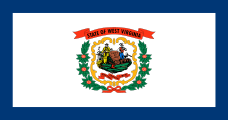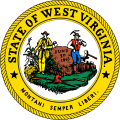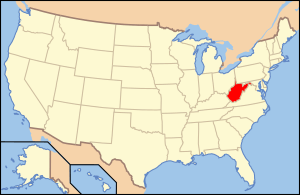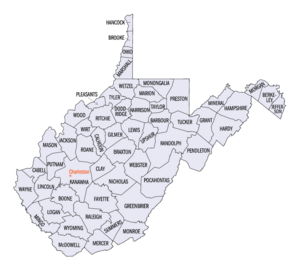Outline of West Virginia facts for kids
West Virginia is a state in the United States of America. It's known for its beautiful mountains and rolling hills. It's also famous for its history in logging (cutting down trees) and coal mining. West Virginia became a state during the American Civil War in 1863. Before that, it was part of Virginia.
Contents
Exploring West Virginia's Geography
West Virginia is a state located in the Appalachian Mountains region of the Southern United States. It's part of North America and the United States.
* Eastern United States * Southern United States
- How many people live there: About 1.85 million people (based on the 2010 U.S. Census).
Cool Places to Visit in West Virginia
West Virginia has many interesting places to explore:
- Historic Sites: These are places important to history.
- National Historic Landmarks are very special places recognized by the whole country.
- Natural Wonders:
- National Natural Landmarks are amazing natural areas.
- National parks and state parks offer beautiful outdoor adventures.
West Virginia's Environment and Wildlife
The state has a diverse environment.
- Climate: West Virginia has a varied climate, with warm summers and cold winters.
- Geology: The land is shaped by mountains, valleys, and rivers.
- Protected Areas: State forests help protect nature.
- Wildlife: West Virginia is home to many animals.
- Birds: You can find many different types of birds.
- Mammals: Animals like deer, bears, and squirrels live here.
- Reptiles: Snakes and lizards are also part of the wildlife.
- Amphibians: Frogs and salamanders thrive in the state's wet areas.
Natural Features of West Virginia
- Islands: There are some islands in the rivers.
- Lakes: Many lakes offer places for fishing and boating.
- Rivers: Important rivers like the New River and the Kanawha River flow through the state.
Regions and Divisions of West Virginia
West Virginia is divided into different areas:
- Eastern Panhandle of West Virginia
- North Central West Virginia
- Northern Panhandle of West Virginia
- Southern West Virginia
How West Virginia is Organized
West Virginia has 55 counties. Each county has its own local government.
- Cities and Towns:
- Cities are larger communities.
- The state capital of West Virginia is Charleston.
- Towns are smaller communities.
- Cities are larger communities.
West Virginia's History
The history of West Virginia is very interesting, especially how it became its own state.
West Virginia's Timeline
- Before History: Long ago, Native American tribes lived here.
- Colonial Times:
- The area was part of the Colony of Virginia (controlled by England, then Britain) from 1607 to 1776.
- Parts were also claimed by France as Louisiane.
- Wars and Changes:
- The French and Indian War (1754–1763) changed who controlled the land.
- The American Revolutionary War (1775–1783) led to the United States Declaration of Independence in 1776.
- Becoming a State:
- West Virginia was part of the Commonwealth of Virginia after the Revolutionary War.
- During the American Civil War (1861–1865), 50 counties in northwestern Virginia decided to break away. They disagreed with Virginia's decision to leave the United States.
- West Virginia officially became the 35th State of the United States on June 20, 1863. It was a "border state" during the Civil War, meaning it was between the Union and Confederate sides.
West Virginia's Culture
The culture of West Virginia is shaped by its mountain heritage and history.
- Museums: Museums help us learn about the state's past and art.
- Religion: Many different religions are practiced here.
- Scouting: Scouting programs are popular for young people.
- Sports: Sports are an important part of community life.
- State Symbols:
- The Flag of the State of West Virginia
 has a blue border and a white center with the state seal.
has a blue border and a white center with the state seal. - The Great Seal of the State of West Virginia
 shows a farmer and a miner, representing the state's agriculture and industry.
shows a farmer and a miner, representing the state's agriculture and industry.
- The Flag of the State of West Virginia
The Arts in West Virginia
- Music: West Virginia music often includes folk, country, and bluegrass styles.
West Virginia's Economy and Transportation
The economy of West Virginia has historically relied on natural resources like coal.
- Communication:
- Newspapers, radio stations, and television stations keep people informed.
- Energy:
- West Virginia produces a lot of energy, especially from coal.
- There's also growing interest in solar and wind power.
- Health Care: Hospitals provide medical care across the state.
- Transportation: Getting around West Virginia involves different ways.
- Airports connect the state to other places.
- Roads: A network of roads helps people travel.
- U.S. Highways and Interstate Highways are major routes.
- State highways connect towns and cities within West Virginia.
Education in West Virginia
Education is important in West Virginia, from elementary schools to universities.
- Schools:
- School districts manage public schools.
- High schools prepare students for college or careers.
- Colleges and Universities:
- Many colleges and universities offer higher education.
- West Virginia University and West Virginia State University are two well-known examples.
- School districts manage public schools.





